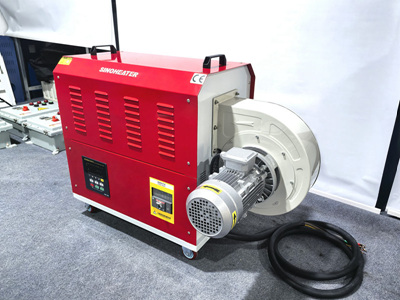Heating Techniques for Leather Punching Using Hot Air Blowers
Leather punching is a critical process in automotive interior manufacturing, fashion accessories, and upholstery. Hot air blowers provide controlled heating to soften leather, reduce cracking risks, and improve punching precision. This guide explores operational parameters, material-specific adjustments, and safety protocols for optimizing leather punching outcomes.
Temperature and Airflow Control for Optimal Leather Softening
Understanding Leather Thermal Properties
Natural leather, derived from animal hides, contains collagen fibers that stiffen when exposed to low temperatures and degrade under excessive heat. Synthetic alternatives, such as PU or PVC-based materials, exhibit lower thermal tolerance, often deforming above 120°C. Operators must reference material specifications to set safe heating thresholds.
Hot Air Blower Parameter Adjustment
- Temperature Settings:
- For cowhide or sheepskin (1.2–1.5mm thickness), maintain temperatures between 80–100°C.
- Thinner leather (0.8–1.0mm) requires lower settings (60–80°C) to prevent edge burning.
- Synthetic materials demand precise control (50–70°C) to avoid surface melting.
- Airflow Management:
- Use low to medium airflow (15–30 L/min) to distribute heat evenly without displacing leather pieces.
- High airflow may cause uneven softening, particularly in textured or embossed surfaces.
- Heating Duration:
- Apply heat for 8–12 seconds per 10cm² area, adjusting based on leather density.
- Monitor surface temperature with infrared thermometers to avoid overheating.
Material-Specific Heating Strategies
Natural Leather Processing
- Full-Grain Leather:
- Preheat to 90°C for 10 seconds to relax fibers without compromising grain integrity.
- Use a wide-nozzle attachment to cover large areas uniformly.
- Suede or Napped Leather:
- Limit temperatures to 70°C to prevent flattening the nap.
- Apply heat in short bursts (5–8 seconds) with intermittent cooling.
- Patent Leather:
- Heat at 60°C to avoid disrupting the glossy coating.
- Use a diffuser nozzle to soften the backing layer without affecting the surface finish.
Synthetic Leather Handling
- PU Leather:
- Maintain temperatures at 55–65°C to prevent adhesive layer separation.
- Avoid prolonged heating, as synthetic bases may warp irreversibly.
- PVC-Coated Fabrics:
- Heat at 50°C for 5–7 seconds to soften the PVC layer.
- Use a flat nozzle to concentrate heat on targeted areas.
Punching Process Optimization
Pre-Punching Preparation
- Surface Cleaning:
- Remove dust, oils, or finishes with isopropyl alcohol (≥99%) to ensure even heat absorption.
- Allow leather to dry completely before heating.
- Fixture Alignment:
- Secure leather in jigs or vacuum holders to prevent movement during heating.
- Align punching dies to cover the entire target area without overlapping edges.
Heating and Punching Execution
- Gradual Ramp-Up:
- Increase temperature in 10°C increments, pausing at each stage to assess leather response.
- Monitor edge curling or discoloration as indicators of excessive heat.
- Uniform Coverage:
- Move the nozzle in a circular motion (5–10 mm/s) to distribute heat evenly.
- For multi-layer assemblies, heat both sides alternately to prevent delamination.
- Post-Heating Stabilization:
- Allow leather to cool naturally for 30–60 seconds before punching.
- Avoid forced cooling, which may introduce moisture and weaken punching accuracy.
Safety and Quality Assurance Protocols
Personal Protective Equipment (PPE)
- Operators must wear heat-resistant gloves (rated for ≥150°C), safety goggles, and flame-retardant clothing.
- Use respirators with organic vapor cartridges when handling adhesives or coatings.
Equipment Maintenance
- Nozzle Cleaning:
- Soak nozzles in acetone for 10–15 minutes after each use to remove resin or adhesive residues.
- Use soft-bristled brushes to avoid scratching internal surfaces.
- Air Filter Replacement:
- Inspect pre-filters monthly and replace them when clogged.
- Change HEPA filters every 200 operating hours to maintain airflow purity.
- Calibration Checks:
- Verify temperature accuracy quarterly using NIST-traceable thermocouples.
- Adjust controller settings if deviations exceed ±5°C.
Emergency Procedures
- Overheating Response:
- If leather exceeds maximum rated temperatures, immediately cut power and move the assembly to a fireproof surface.
- Do not attempt to remove melted sections until cooled.
- Airflow Blockage:
- Install pressure sensors in the air supply line to detect obstructions.
- The system should automatically shut down if airflow drops below 10 L/min.
By integrating these techniques, manufacturers can achieve precise leather punching while maintaining material integrity and operator safety. Continuous monitoring of thermal parameters and adherence to material-specific guidelines ensure consistent, high-quality results in automotive and fashion applications.




